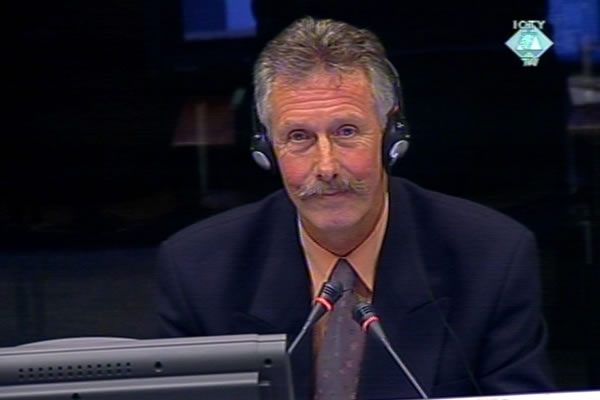Home
WITNESS: EVERYTHING WAS ORGANIZED IN SREBRENICA
As the trial of Radovan Karadzic continues, video recordings of the first two meetings with Ratko Mladic immediately after the Serb forces entered Srebrenica on 11 July 1995 were shown in court. New prosecution witness Evert Rave says that everything that happened in Srebrenica, including the deportation of Muslims, had been ‘organized beforehand’
 Evert Albert Rave, witness at the Radovan Karadzic trial
Evert Albert Rave, witness at the Radovan Karadzic trial Former Republika Srpska president Radovan Karadzic continued his cross-examination of Dutch officer Pieter Boering today. Karadzic repeated his claim that the Serb forces posed no threat for the civilian population of Srebrenica in July 1995. The people headed towards the UN base in Potocari ‘of their own will’; they were motivated by their ‘own assessments of the situation and fears’. Boering rejected Karadzic’s claim, as had the previous prosecution witness Johannes Rutten, claiming that there was a ‘great fear’ among the people: the fear, the witness said, was justified.
Another witness from Holland, Evert Albert Rave, was called to testify next. In 1995, Rave was field security adviser to the Dutch Battalion commander Karremans. The witness’s written statement based on his testimonies at the trials of Radislav Krstic and Zdravko Tolimir was admitted into evidence. The videos of two meetings with General Ratko Mladic in the evening of 11 July 1995 in the Fontana Hotel in Bratunac were shown in court.
At the first meeting with the Dutch Battalion commander Karremans, Mladic told the Blue Helmets they could ‘either all get out of here or all die’. Rave and Boering attended the meeting too. Mladic demanded that the Blue Helmets bring them Muslim representatives from Potocari by 11pm that night. The Dutch returned that evening to the Fontana Hotel with a teacher, Nesib Mandzic. When he sat down at the table, someone put a plaque saying ‘Srebrenica Municipal Assembly’ in front of Mandzic. According to the witness, this was to show that Mladic had Srebrenica in his hands.
The witness claims that everything that happened after the Serb forces entered Srebrenica was ‘organized beforehand’. Buses and trucks that Mladic requested on 11 July 1995 around midnight arrived in Potocari by the next morning, the witness explained. There was also the way in which women were separated from men and the ‘media show’ orchestrated by the VRS cameramen who filmed everything that needed to be filmed, including Mladic handing out candy to children, shouting at the Dutch officers and ‘offering’ the refugees the choice between ‘survival or disappearance’, the witness noted.
In the cross-examination, Karadzic tried to contest the witness’s claim that everything had been ‘organized beforehand’. Karadzic argued that Mladic in fact proceeded according to the wishes of the Bosnian leadership, which had asked the UN Secretary-General’s special envoy Akashi to evacuate the people from Srebrenica. The witness replied he was unaware of it. Karadzic then asked him if his superior officer, Karremans might know more about it. The witness told Karadzic he should ask the former commander of the Dutch Battalion.
The accused also claimed that in July 1995 there were between 4,000 and 8,000 Muslim fighters ‘masquerading as civilians’ in Srebrenica. They would fire on the Serbs from positions close to the UN observation posts. Karadzic used an old folk saying to illustrate this method: ‘hiding behind an old man to shoot a bear’. What the Muslims wanted was to draw the Dutch into the war. Karadzic elaborated on his claim about soldiers ‘masquerading as civilians’, saying that at the beginning of the war 85% of Muslims fought in civilian clothing. By the end of the war this number dropped to 30%, Karadzic claimed.
The witness agreed that the Muslims opened fire on the Serb positions from positions near the Dutch observation posts on a couple of occasions. However, the witness couldn’t say anything about the number of soldiers in the enclave. The witness said that he hadn’t seen any armed formations in the streets of Srebrenica. The witness also said that in the night before the fall of Srebrenica he saw Muslim soldiers armed mostly with infantry weapons leaving Srebrenica, heading northwest.
